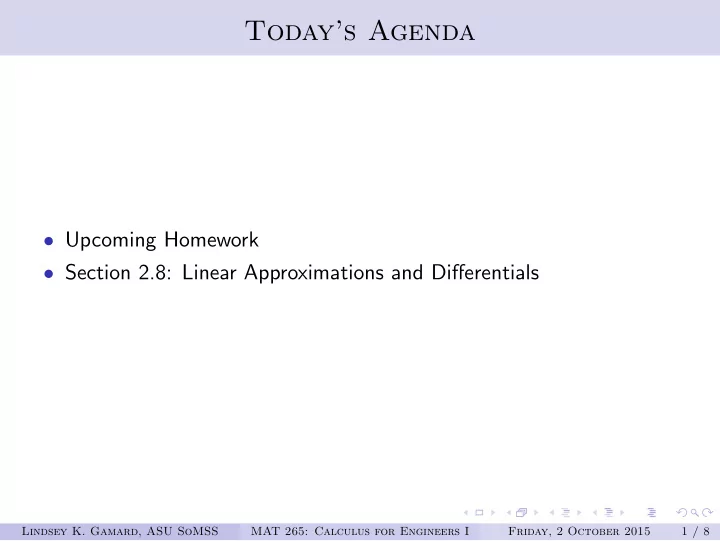

Today’s Agenda • Upcoming Homework • Section 2.8: Linear Approximations and Differentials Lindsey K. Gamard, ASU SoMSS MAT 265: Calculus for Engineers I Friday, 2 October 2015 1 / 8
Upcoming Homework • WeBWorK HW #11 (Section 2.8), due 10/5 • Written HW F (Sections 2.7 and 2.8) due 10/7 • WeBWorK HW #12 (Sections 3.1 and 3.2) due 10/9 Lindsey K. Gamard, ASU SoMSS MAT 265: Calculus for Engineers I Friday, 2 October 2015 2 / 8
Section 2.8 Definition 2.8.1 Given a function f ( x ) that is differentiable at a point a , we say that the linear approximation of f at a , or the tangent line approximation of f at a , denoted L ( x ), is the function whose graph is the tangent line at a : L ( x ) = f ( a ) + f ′ ( a )( x − a ) . Example 2.8.2 Find the linear approximation of f ( x ) = x 4 + 3 x 2 at the point a = − 1. Lindsey K. Gamard, ASU SoMSS MAT 265: Calculus for Engineers I Friday, 2 October 2015 3 / 8
Section 2.8 Linear approximations are helpful when you have a ”difficult” function to evaluate and a certain margin of error in computation is allowable. An almost trivial example follows: Example 2.8.3 Let f ( x ) = tan x . 1 Find the linear approximation of f ( x ) at a = 0. 2 If an error in calculation of ± 0 . 1 is allowable, find the values of x for which L ( x ) can be used to approximate f ( x ). One example of when this is useful: the classic pendulum experiment in an introductory physics class. The tangential acceleration of the bob of the pendulum is given by the equation a T = − g sin θ , but for very small angles, sin θ ≈ θ , and so one can simply use a T = − 9 . 8 θ in the experiment instead of needing to calculate the sine for each piece of data. Lindsey K. Gamard, ASU SoMSS MAT 265: Calculus for Engineers I Friday, 2 October 2015 4 / 8
Section 2.8 Given a function f ( x ) and a change in x denoted by ∆ x , recall that we can calculate the corresponding ∆ y via the formula: ∆ y = f ( x + ∆ x ) − f ( x ) . If we consider instead L ( x ), we can approximate the change in y by the formula dy = f ′ ( x ) dx . Definition 2.8.4 If y = f ( x ), where f is a differentiable function, then the differential dx is an independent variable; that is, dx can be given the value of any real number. The differential dy is then defined in terms of dx by the equation dy = f ′ ( x ) dx . Lindsey K. Gamard, ASU SoMSS MAT 265: Calculus for Engineers I Friday, 2 October 2015 5 / 8
Section 2.8 The formula for the differential can be a bit confusing, because the differential dy is specific to a point a . As an example, consider f ( x ) = tan x again. The differential at the point a = 0 is dy = sec 2 (0) dx = dx , but the differential at the point a = π/ 3 is dy = sec 2 ( π/ 3) dx = 4 dx . We must be very careful to pay attention to whether a formula for the differential is required, or whether the differential at a specific point is required. Another confusing part of the differential is that its notation is very, very similar to the notation for the derivative dy / dx . It is tempting to interpret dy = dy dx dx as multiplying a fraction by its denominator and ”clearing the denominator.” However, remember that dy / dx is NOT a fraction; dx y = dy d dx is the action of the derivative operator on the function y . Lindsey K. Gamard, ASU SoMSS MAT 265: Calculus for Engineers I Friday, 2 October 2015 6 / 8
Section 2.8 To visualize ∆ x , ∆ y , dx , and dy , consider the following graph (found on page 137 of your textbook): Lindsey K. Gamard, ASU SoMSS MAT 265: Calculus for Engineers I Friday, 2 October 2015 7 / 8
Section 2.8 Example Problems 1 The edge of a cube is measured to be 30 cm ± 0 . 1 cm. Use differentials to estimate the maximum possible error in computing 1 the volume and surface area of the cube. What is the volume of a 29.9 cm cube? How does this compare to your 2 estimate in part (a)? 2 The radius of a circular disk is given as 24 cm with a maximum error in measurement of 0.5 cm. Use differentials to estimate the maximum error in calculating the area 1 of the disk. What is the actual area of a 24.5 cm disk? How does this compare 2 with your estimate in part (a)? 3 Use differentials to estimate the amount of paint needed to apply a coat of paint 0.05 cm thick to a hemispherical dome with diameter 50 m (recall that the volume of a sphere is given by V = 4 3 π r 3 ). Lindsey K. Gamard, ASU SoMSS MAT 265: Calculus for Engineers I Friday, 2 October 2015 8 / 8
Recommend
More recommend